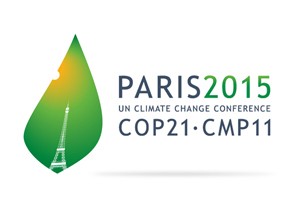Justin Gundlach
Climate Law Fellow
Justin spent the past week at the Paris climate conference working on behalf of the Legal Response Initiative
the Legal Response Initiative
Negotiators at the Paris climate conference have completed a first draft of an agreement, but one that is full of “brackets” – meaning that many of the key provisions contain several alternative terms, reflecting specified disagreements among the parties. Take, for example, the following bracketed terms in Article 2, paragraph 1: “Parties agree to take urgent action and enhance cooperation and support so as: (a) To hold the increase in the global average temperature [below 1.5 °C] [or] [well below 2 °C] above pre-industrial levels by ensuring deep reductions in global greenhouse gas [net] emissions.” The first three bracketed terms reflect disagreement among the parties over how to define the agreement’s basic emissions reduction goal, expressed in terms of global average temperature rise. As for the fourth bracketed term, including it arguably contemplates a scenario in which developing countries’ emissions continue to grow but are more than offset by developed countries’ emissions reductions. As inclusion of such contentious terms reflects, the first draft is not meant to resolve basic disagreements, but rather to isolate and highlight them so that higher-ranking ministers (as opposed to lower-ranking diplomats) can hash out compromises quickly.
That some issues remain bracketed in the first draft is predictable. This is especially true in regards to the question of whether or not and how to include a “loss and damage” provision. One version of such a provision could, arguably, be read to establish legal liability for past emissions of anthropogenic greenhouse gas (GHG)—something that developed nations are at pains to avoid. Excluding such a provision altogether, however, is unacceptable for many countries that have historically emitted few anthropogenic GHGs yet face significant adverse consequences from climate change. Currently, Article 5 of the draft is titled “Loss and Damage,” and, as written, would incorporate the Warsaw International Mechanism for Loss and Damage associated with Climate Change Impacts into the new agreement. However, the whole of Article 5 is bracketed, and follows a note indicating that the Article’s contents might be included in Article 4, “Adaptation,” instead of standing alone as Article 5.
This post focuses on disagreement over a point more subtle than the examples above: the entry into force provision. As explained below the jump, the question of how the agreement should take effect highlights a basic problem for negotiators, namely building consensus on the derivation of national and aggregated GHG emissions inventories.
Conceptually, an entry into force provision is simple. It specifies the event or timing that will cause an agreement to transform from mere words on a page into a document with material legal implications for those party to it. The three options for triggering entry into force currently being considered in Paris are as follows: 1) adoption of the agreement by a minimum number of negotiating parties; 2) adoption by parties whose aggregate emissions exceed a particular numeric or percentage threshold; or 3) adoption by a group of parties that satisfies both 1) and 2). The draft text currently looks like this:
“This Agreement shall enter into force on the thirtieth day after the date on which at least [X] [50][55][100] [the ¾] Parties to the Convention [including all Annex I Parties] [and][or] [on which Parties to the Convention accounting for [55][60][70][X] per cent of total [net] global greenhouse gas emissions in [[date][1990][2000][2010][2012]].”
Even though these options are all simply stated, implementing the second or third of them would require answering an intertwined set of technical and political questions about how to count and attribute emissions to all the parties to the agreement. Thus discussion of entry into force has encountered the distrust and jostling for position that any thorough and uniform emissions accounting must overcome.
The question of how to count and attribute GHGs is crucially important and not new, but also is not settled—even though the Intergovernmental Panel on Climate Change (IPCC) has worked for two decades to develop and refine guidelines for analytically rigorous emissions inventories. In anticipation of COP21 in Paris, developed countries submitted inventories consistent with those guidelines for the years 1990-2012, and developing countries, which in many cases lack the capacity to compile complete and accurate inventories, submitted data from more sporadic and generally incomplete data collection efforts. In addition, political angling consistently enters into technical discussions in at least two places: 1) when considering how to account for emissions related to land use, and 2) when deciding on a baseline year for analyzing emissions changes—note that the block of draft text quoted above presents five(!) options for a baseline year, and that China’s emissions profile is categorically different today relative to 1990.
The Intergovernmental Panel on Climate Change (IPCC) has developed parameters for taking a GHG inventory, and the UNFCCC Secretariat has made several resources available to facilitate inventorying by less developed countries. For example, a Consultative Group of Experts, operating pursuant to a decision taken at the Warsaw COP in 2013, has conducted seminars and webinars with developing countries and the UNFCCC has made GHG accounting software available for several years. But even this sort of facilitation necessarily entails use of one approach instead of others, and the decisions that lead to any particular approach will necessarily have “winners” and “losers” in terms of the accounting of emissions and carbon sinks. In addition, notwithstanding a voting process intended to represent all parties in the IPCC leadership, distrust of methodologies and tools developed elsewhere persists in many developing countries.
By using a non-emissions-based threshold, the parties could sidestep the need to resolve disagreements over country-level GHG emissions accounting in the context of a decision about how the agreement should enter into force. But, of course, they cannot avoid the need for generally accepted emissions accounting principles more generally. As less than a week remains to negotiate an agreement here in Paris, resolution will almost certainly take the form of a further technical process, combined with a stipulation that all will abide by its outcomes.



